I recently purchased a beautiful leaning mirror to add a touch of elegance to my bedroom decor. However, I quickly realized that the mirror was not stable and needed to be secured to prevent it from falling and causing damage or injury. If you also have a leaning mirror, you may be wondering how to secure it on a dresser or against a wall to ensure its stability.
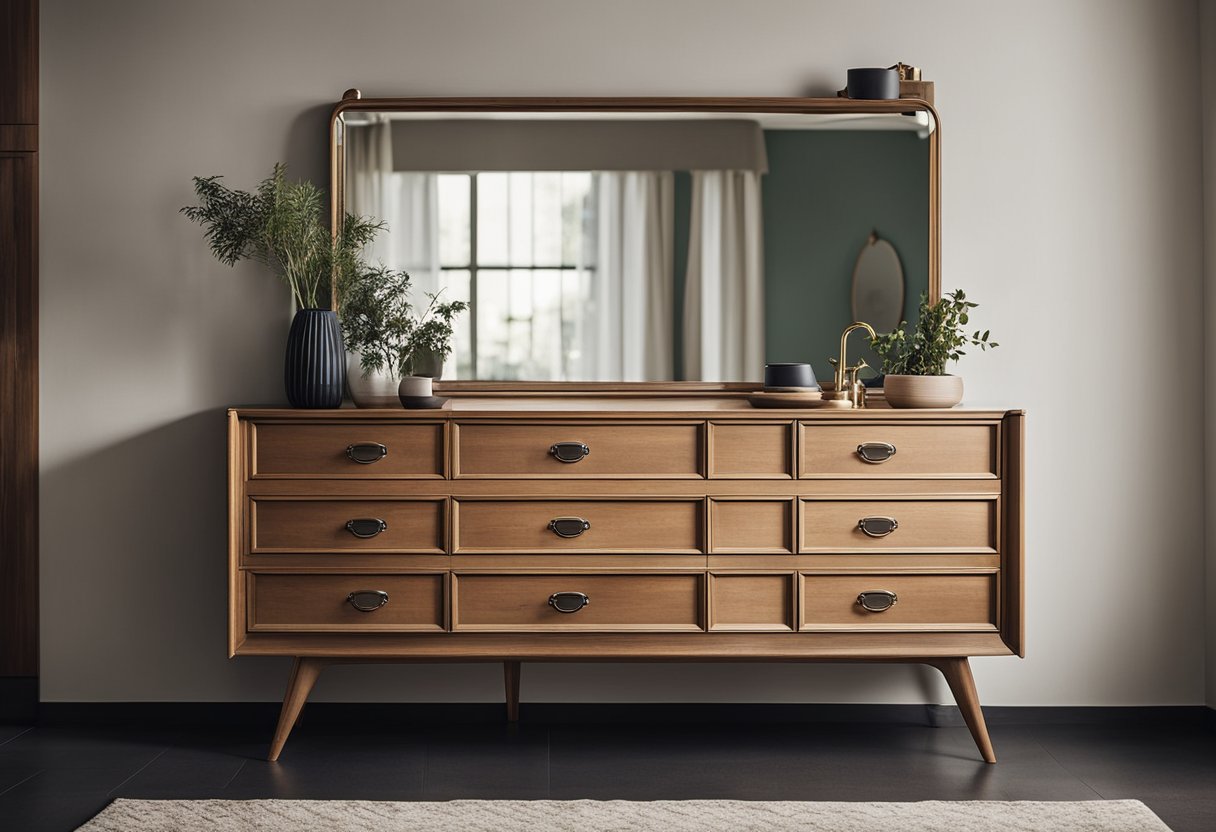
In this article, I will share a step-by-step guide on how to secure a leaning mirror on a dresser or against a wall. I will cover the materials required, preparation before installation, securing the mirror to the dresser, attaching the mirror to the wall, ensuring stability and balance, and maintaining your leaning mirror. By following these simple steps, you can ensure that your leaning mirror stays in place and adds beauty and functionality to your room.
Key Takeaways
- Securing a leaning mirror on a dresser or against the wall is essential to prevent it from falling and causing damage or injury.
- To secure a leaning mirror, you need to use the right materials and follow specific steps, including preparing the area, securing the mirror to the dresser or wall, and ensuring stability and balance.
- By following these simple steps, you can enjoy a beautiful and functional leaning mirror in your room.
Understanding Leaning Mirrors
As a design element, leaning mirrors are a popular choice for homeowners who want to add a touch of beauty to their bedroom. A leaning mirror is a full-length mirror that leans against a wall or dresser, rather than being hung up. Leaning mirrors are a great way to add depth and dimension to a room while also making it appear larger.
However, leaning mirrors can also pose a safety risk if not properly secured. If a leaning mirror falls, it can cause serious injury or damage to the surrounding furniture. Therefore, it’s important to understand how to properly secure a leaning mirror on a dresser.
When choosing a leaning mirror, it’s important to consider the design and weight of the mirror. Some leaning mirrors are designed to be more stable than others, so it’s important to choose a mirror that is sturdy and well-balanced. Additionally, the weight of the mirror can affect how it should be secured. A heavier mirror may require more support than a lighter one.
To properly secure a leaning mirror on a dresser, there are several methods that can be used. These include using hardware with brackets and metal plates, attaching the mirror to the wall, or using wood strips to secure the mirror to the dresser. Each method has its own benefits and drawbacks, so it’s important to choose the method that works best for your specific situation.
In summary, leaning mirrors are a beautiful and popular design element for bedrooms, but they can also pose a safety risk if not properly secured. By understanding the design and weight of your mirror and choosing the appropriate method for securing it, you can enjoy the beauty of a leaning mirror while also ensuring the safety of yourself and your furniture.
Materials Required
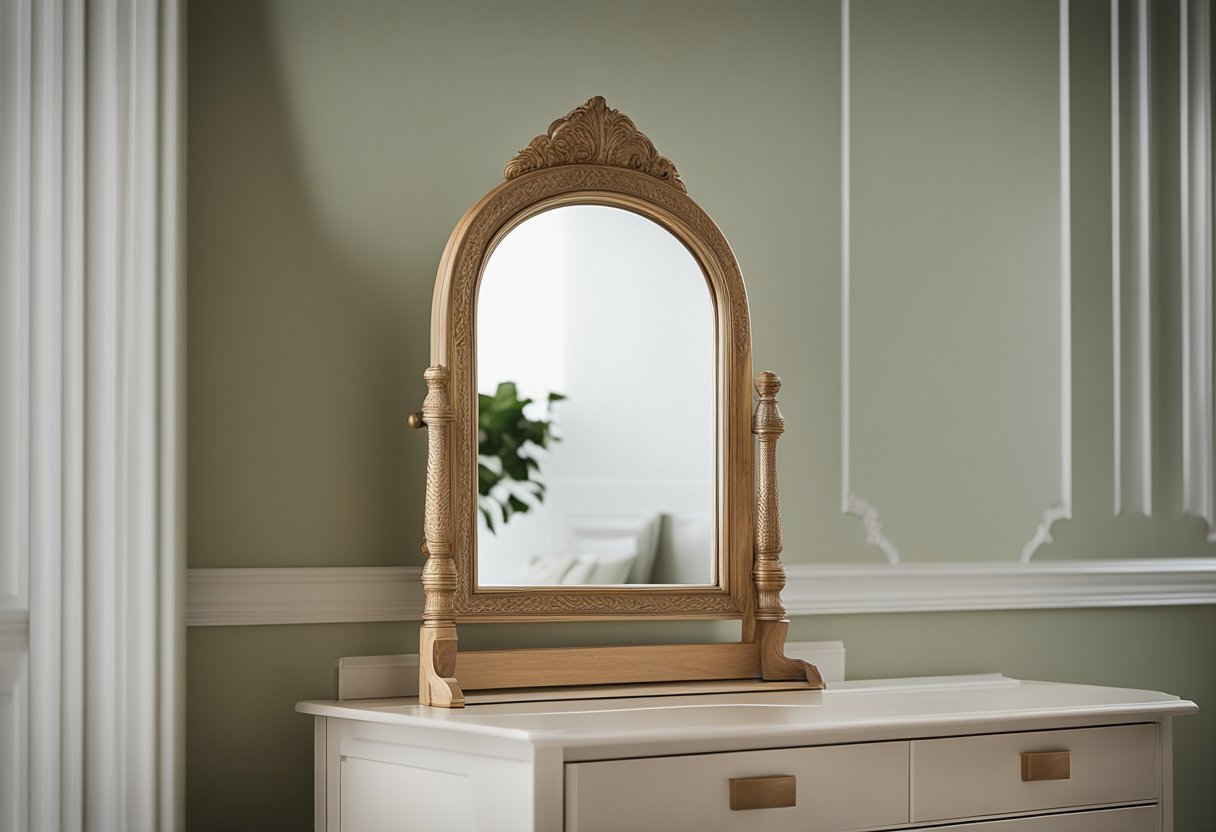
To secure a leaning mirror on a dresser, you will need the following materials:
-
Screws: You will need screws to attach the mirror to the dresser. Make sure to use the right size and type of screw depending on the weight of the mirror and the material of the dresser. You can use wood screws or machine screws, depending on the situation.
-
Hardware: You can use different types of hardware to secure a leaning mirror on a dresser. Some common hardware options include brackets, flat bracket plates, L-brackets, and heavy-duty brackets. Make sure to choose the right hardware depending on the weight and size of the mirror.
-
Drill: You will need a drill to make holes in the dresser and attach the hardware. You can use a power drill or a hand drill, depending on your preference and experience.
-
Wood: You can use wood strips or blocks to create a stable base for the mirror. You can attach the wood strips to the back of the mirror using wood screws.
-
Pencil: You will need a pencil to mark the position of the hardware and drill holes in the dresser. Make sure to use a sharp pencil that can make clear and visible marks.
-
Furniture straps: You can use furniture straps to secure the mirror to the wall and prevent it from tipping over. Make sure to use high-quality and durable furniture straps that can support the weight of the mirror.
-
Wall anchor: You will need a wall anchor to secure the furniture straps to the wall. Make sure to choose the right type and size of wall anchor depending on the material of the wall and the weight of the mirror.
-
Hanging rings and hooks: You can use hanging rings and hooks to attach the mirror to the wall. Make sure to choose the right type and size of hanging rings and hooks depending on the weight and size of the mirror.
-
Rubber: You can use rubber pads or bumpers to cushion the back of the mirror and prevent scratches or damage to the dresser. Make sure to choose the right size and thickness of rubber pads depending on the size of the mirror.
In summary, to secure a leaning mirror on a dresser, you will need screws, hardware, a drill, wood, a pencil, furniture straps, wall anchors, hanging rings and hooks, and rubber pads or bumpers. Make sure to choose the right materials and tools depending on the weight, size, and material of the mirror and the dresser.
Preparation Before Installation
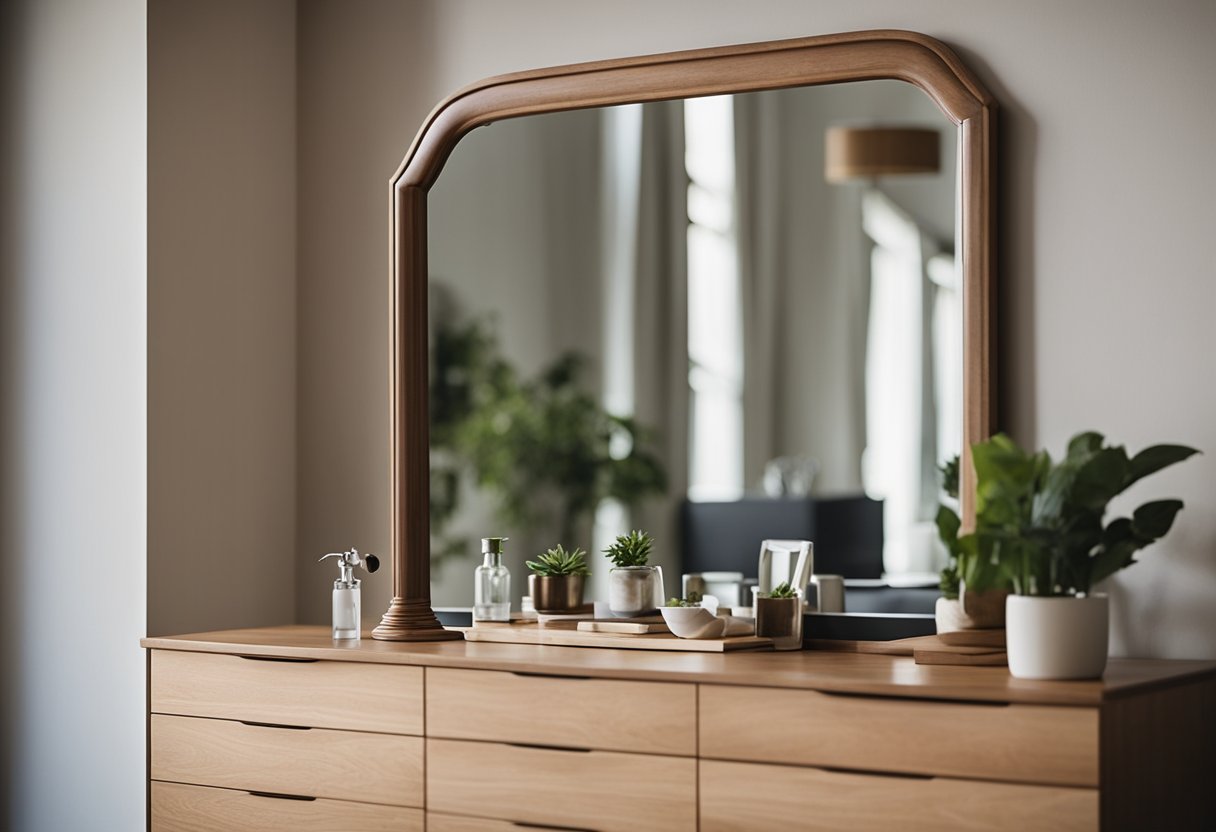
Before installing a leaning mirror on a dresser, it is important to prepare the space and materials to ensure a secure and stable installation. Here are some important steps to follow:
1. Measure the space and mark the center
The first step in preparing for the installation of a leaning mirror on a dresser is to measure the space where the mirror will be placed. Measure the height and width of the dresser surface to ensure that the mirror will fit comfortably and securely. Once you have measured the space, mark the center of the dresser surface with a pencil or other marking tool. This will help you position the mirror correctly and ensure that it is balanced.
2. Check the height of the mirror
Before installing the mirror, it is important to check its height and ensure that it is appropriate for the space. A mirror that is too tall or too short can look awkward and out of place. Measure the height of the mirror and compare it to the height of the dresser surface to ensure that it will be a good fit.
3. Choose a stable and secure location
When choosing a location for the leaning mirror on the dresser, it is important to choose a stable and secure location. Avoid placing the mirror on an uneven or unstable surface, as this can cause it to tip over or become unbalanced. Choose a location that is flat and level, and ensure that the dresser is sturdy and secure.
4. Prepare your outfits
Finally, it is important to consider how the mirror will be used and prepare your outfits accordingly. If you plan to use the mirror to try on outfits or get ready in the morning, ensure that there is enough space around the dresser to move freely. This will help you make the most of your new mirror and ensure that it is a valuable addition to your space.
Securing the Mirror to the Dresser
When it comes to securing a leaning mirror to a dresser, there are a few methods you can use to ensure it stays safely in place. Here are some steps you can follow to securely attach the mirror to the dresser:
Method 1: Using Heavy-Duty Brackets and Metal Plates
One of the most popular ways to secure a leaning mirror to a dresser is by using heavy-duty brackets and metal plates. To do this, you will need to follow these steps:
- First, purchase some metal brackets and metal plates.
- Attach the metal plates to the back of the mirror using screws.
- Use heavy-duty brackets to attach the mirror to the dresser.
This method is effective because it provides strong support for the mirror and helps to distribute the weight evenly.
Method 2: Using Wood Strips and Wood Screws
Another way to secure a leaning mirror to a dresser is by using wood strips and wood screws. Here’s how you can do it:
- Cut two 4-feet pieces of 1 by 2-inch wood strips.
- Attach one half of the strip’s vertical length to the back of the mirror using screws.
- Attach the other half of the strip to the back of the dresser using wood screws.
- Measure the mirror width of the mirror frame and cut a piece of wood to that length.
- Screw the wood strip to the dresser surface and attach the mirror to the wood strip using hanging rings.
This method is effective because it provides solid support for the mirror and helps to distribute the weight evenly.
Method 3: Using L-Brackets and Wall Anchors
A third method to secure a leaning mirror to a dresser is by using L-brackets and wall anchors. Here’s how you can do it:
- Position the mirror on the dresser and mark where you want to attach it.
- Pre-drill holes in the dresser surface and attach the L-brackets using screws.
- Attach the mirror to the L-brackets using screws.
- Use wall anchors to secure the L-brackets to the wall for added stability.
This method is effective because it provides a secure attachment for the mirror and helps to distribute the weight evenly.
Attaching the Mirror to the Wall
When it comes to securing a leaning mirror on a dresser, one of the most important steps is attaching the mirror to the wall. This will help ensure that the mirror stays securely in place and doesn’t tip over, which could cause damage or even injury.
To attach the mirror to the wall, you’ll need a few key tools and materials. These may include screws, wall anchors, brackets, a drill, and a support system to hold the mirror in place. The exact tools you’ll need will depend on the size and weight of your mirror, as well as the type of wall you’re attaching it to.
One option for attaching a leaning mirror to the wall is to use heavy-duty brackets and metal plates. This involves attaching the metal plates to the back of the mirror using screws or other hardware, and then using the brackets to secure the mirror to the wall. This method can be very effective for larger, heavier mirrors, but may require some additional support to ensure that the mirror stays securely in place.
Another option is to use hanging rings or other hardware that can be attached to the back of the mirror and then hung securely on the wall. This method may be simpler and quicker than using brackets, but may not be as secure for larger or heavier mirrors.
Regardless of the method you choose, it’s important to ensure that your mirror is securely attached to the wall and won’t tip over or fall off. This may involve using rubber or other materials to help cushion the mirror and prevent damage, as well as using cable or other supports to help hold the mirror in place.
Overall, attaching a leaning mirror to the wall can be done in just a few minutes with the right tools and materials. By taking the time to secure your mirror properly, you can help ensure that it stays safely in place and looks great for years to come.
Ensuring Stability and Balance
When it comes to securing a leaning mirror on a dresser, ensuring stability and balance is crucial to prevent accidents and damage to your furniture. Here are some tips to help you achieve a secure and balanced mirror:
Use Furniture Straps or Flat Bracket Plates
One of the easiest and most effective ways to secure a leaning mirror on a dresser is by using furniture straps or flat bracket plates. These can be easily attached to the back of the mirror and the dresser, and provide a secure anchor to prevent the mirror from tipping over. Simply pre-drill holes in the dresser and attach the straps or plates with wood screws.
Use Wood Strips or L-Brackets
Another option is to use wood strips or L-brackets to secure the mirror to the dresser. Cut down two 4-feet pieces of 1 by 2-inch wood strips and attach half of each strip to the back of the mirror and the other half to the back of the dresser using wood screws. Alternatively, you can use L-brackets to attach the mirror to the dresser, making sure to pre-drill holes and use the appropriate screws.
Ensure Proper Balance
In addition to securing the mirror to the dresser, it’s important to ensure proper balance to prevent the mirror from leaning or tipping over. Make sure the dresser is level and stable, and adjust the mirror’s position until it is evenly balanced. You can also use furniture pads or anti-slip mats underneath the dresser legs to provide additional stability.
By following these tips and using the appropriate hardware, you can securely and safely attach a leaning mirror to your dresser, ensuring both stability and balance.
Maintaining Your Leaning Mirror
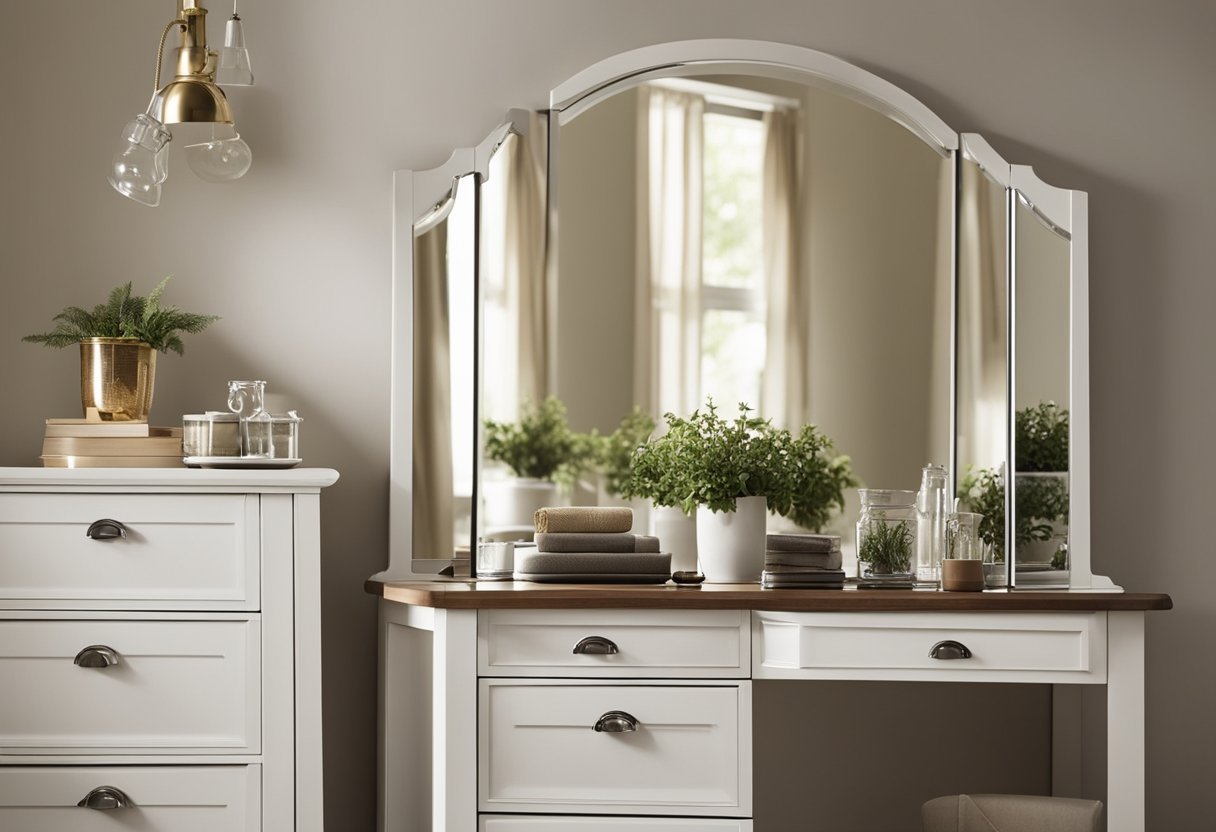
As someone who has owned multiple leaning mirrors, I know that maintaining them is key to keeping them looking beautiful and functioning properly. Here are some tips to help you maintain your leaning mirror:
Keep it Clean
Dust and dirt can accumulate on your leaning mirror, making it look dull and unattractive. To keep it looking its best, you should clean it regularly. You can use a soft cloth or a microfiber cloth to wipe down the mirror. If there are any stubborn spots, you can use a glass cleaner to remove them. Just make sure that you don’t spray the cleaner directly onto the mirror, as it can seep behind the frame and damage the wood or other materials.
Check the Frame
The frame of your leaning mirror is just as important as the mirror itself. If the frame is damaged or warped, it can cause the mirror to lean or even fall over. You should check the frame regularly to make sure that it is in good condition. If you notice any cracks or other damage, you should repair it as soon as possible. If the frame is made of wood, you can use wood glue or filler to fix any cracks or holes.
Secure it to the Dresser
One of the best ways to maintain your leaning mirror is to secure it to the dresser. This can help prevent it from falling over and causing damage or injury. There are several methods you can use to secure a leaning mirror to a dresser, including using heavy-duty brackets and metal plates, wood strips, or even anchors and screws. Make sure to follow the manufacturer’s instructions carefully and use the appropriate hardware for your specific mirror and dresser.
By following these tips, you can help ensure that your leaning mirror stays beautiful and functional for years to come.
Frequently Asked Questions
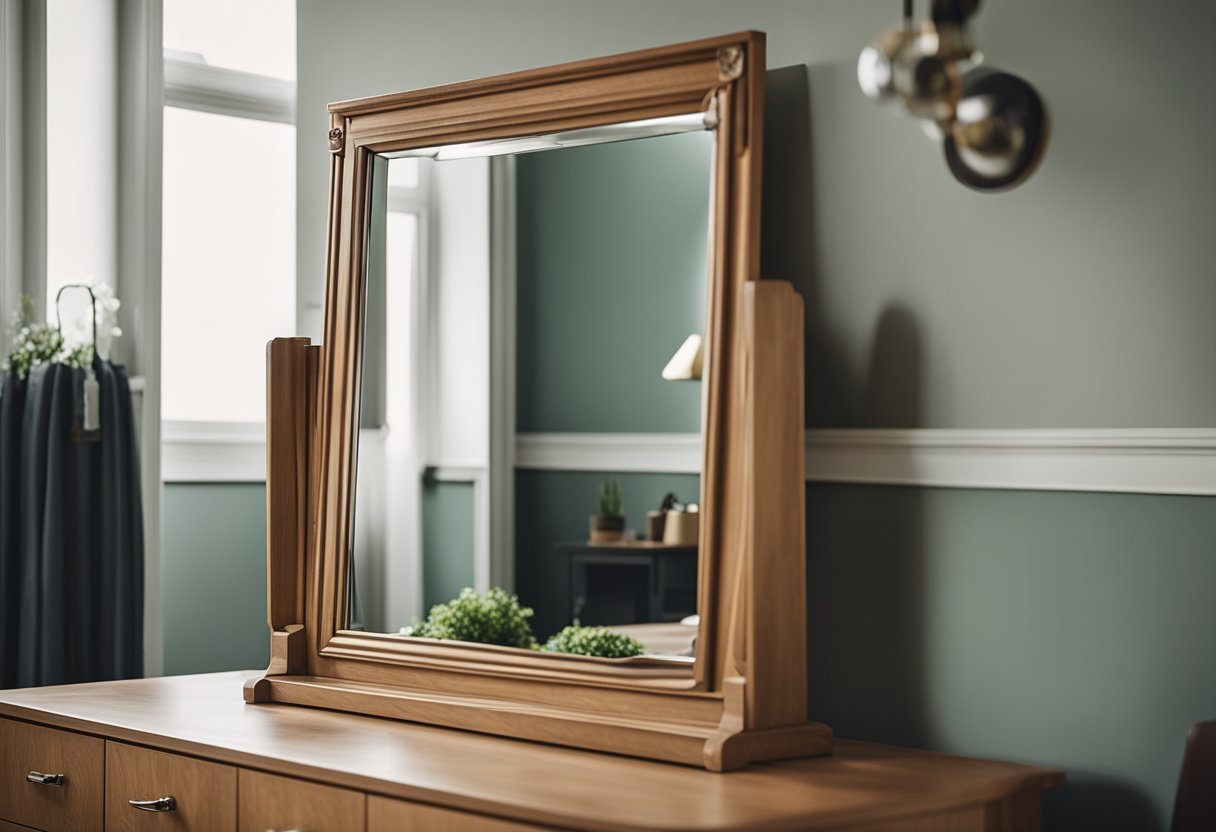
What are the best ways to secure a leaning mirror against a wall?
The best ways to secure a leaning mirror against a wall is to use wall anchors, brackets, or straps. You can use heavy-duty brackets and metal plates to attach the mirror to the wall. You can also use wall anchors to secure the mirror to the wall.
How can I prevent a leaning mirror from falling down?
To prevent a leaning mirror from falling down, you should secure it to the wall or dresser. You can use wall anchors or brackets to secure the mirror to the wall. You can also use rubber stoppers to prevent the mirror from sliding.
Are there any recommended wall anchors for securing a leaning mirror?
Yes, there are recommended wall anchors for securing a leaning mirror. You can use toggle bolts, Molly bolts, or plastic anchors. These types of anchors are strong enough to support the weight of a leaning mirror.
Can a leaning mirror be safely placed on a dresser?
Yes, a leaning mirror can be safely placed on a dresser if it is secured properly. You can use brackets or straps to secure the mirror to the dresser. Make sure the dresser is sturdy enough to support the weight of the mirror.
What are some alternatives to using wall anchors to secure a leaning mirror?
Some alternatives to using wall anchors to secure a leaning mirror include using brackets, straps, or adhesive strips. You can use heavy-duty brackets and metal plates to attach the mirror to the wall. You can also use straps to secure the mirror to the wall.
Is it necessary to use rubber stoppers when securing a leaning mirror?
No, it is not necessary to use rubber stoppers when securing a leaning mirror. However, rubber stoppers can help prevent the mirror from sliding and provide additional stability. If you decide to use rubber stoppers, make sure they are placed securely and evenly on the bottom of the mirror.

Hi, I’m Sal Muller of Tooltrip.com. My DIY experience led me to understand essential power tools for home projects. Tooltrip.com guides enthusiasts and professionals in choosing right tools for any job. I provide concise top tool reviews for easier, efficient DIY.

